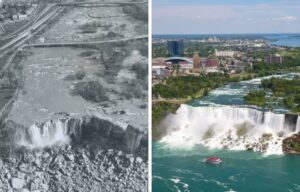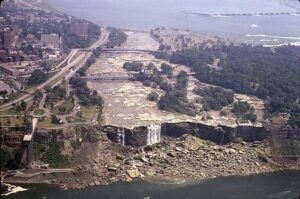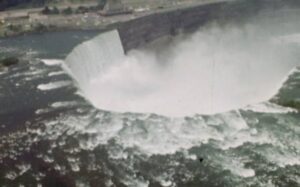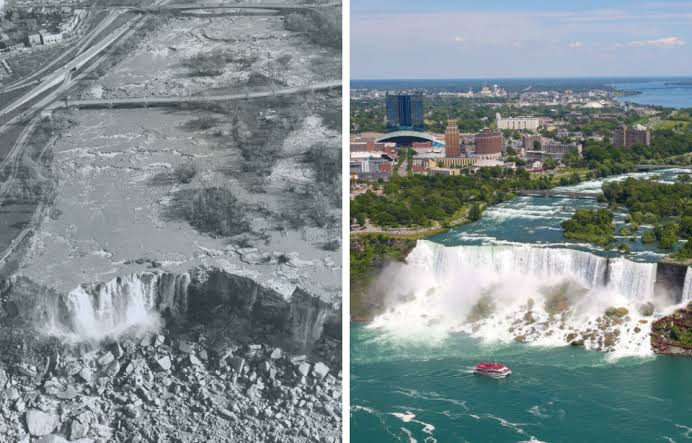When the U.S. turned off their part of Niagara Falls
Niagara Falls, one of the world’s most famous natural wonders, has captivated people for centuries with its sheer power and breathtaking beauty. Composed of three distinct waterfalls—Horseshoe Falls, Bridal Veil Falls, and the American Falls—Niagara straddles the border between the United States and Canada. While many assume that the falls have been flowing uninterrupted for thousands of years, there was one extraordinary moment in history when part of this iconic landmark was turned off.

In 1969, the American Falls—the portion of Niagara Falls that lies within U.S. territory—was deliberately dried up. This monumental engineering feat was not done for spectacle but rather as part of a scientific study to determine how to preserve the falls for future generations. For several months, water that would normally cascade over the American Falls was rerouted, leaving behind an eerie, dry rock face that revealed secrets hidden beneath the roaring waters for centuries.
Why Was Niagara Falls Turned Off?
The idea of dewatering the American Falls arose from growing concerns over its long-term stability. Over the years, large rockslides had significantly altered its appearance. As early as the 19th century, geologists and conservationists worried that erosion would eventually transform

One of the most notable rockslides occurred in 1954 when a massive chunk of rock broke away from the face of the falls. Another significant collapse in 1965 heightened fears that the waterfall’s beauty was in jeopardy. These events prompted the U.S. Army Corps of Engineers to step in and conduct a detailed study of the geological conditions of the falls.
The Plan to Stop the Water Flow
The project to dry out the American Falls began in June 1969. The U.S. Army Corps of Engineers, in collaboration with the International Joint Commission (a U.S.-Canadian organization), developed a plan to divert the Niagara River’s flow away from the American Falls and send the water exclusively over Horseshoe Falls, the largest of Niagara’s waterfalls.
To accomplish this, engineers constructed a 600-foot (183-meter) cofferdam—a temporary barrier made of steel and rock—upstream of the American Falls. This cofferdam blocked the river’s flow and redirected approximately 60,000 gallons of water per second toward Horseshoe Falls.
By June 12, 1969, the last trickle of water over the American Falls ceased, leaving the waterfall eerily dry for the first time in recorded history.

What Was Found Beneath the Falls?
As soon as the water stopped flowing, researchers, geologists, and even curious onlookers marveled at the exposed rock face. The riverbed, which had been submerged for thousands of years, was suddenly visible, revealing geological formations, debris from past rockslides, and even a few human remains.
Perhaps the most shocking discovery was the presence of two human skeletons. It was never determined how long they had been there, though authorities suspected they were victims of accidental falls or suicides, as Niagara Falls has long been a site for both.
The drying of the falls also allowed engineers to carefully examine the layers of sediment and rock that made up the waterfall. They found that the talus—rock debris at the base of the falls—was accumulating at an alarming rate, confirming fears that the American Falls could eventually be transformed into a gentle cascade rather than a dramatic drop.
Efforts to Preserve the Falls
After months of study, the engineers and geologists faced a crucial decision: Should they remove the talus at the base of the falls to restore its original appearance, or should they leave it as a natural part of the landscape?
Some argued for removing the rocks to restore the falls’ dramatic vertical drop. However, others believed the talus should be left alone, as removing it could lead to even more instability. Ultimately, the decision was made to leave the rock debris in place, preserving the falls in their natural state.
To slow erosion, engineers installed steel bolts and anchors to stabilize parts of the rock face. They also developed ongoing monitoring programs to track further changes in the falls’ structure over time.
The Return of the Water
On November 25, 1969, after five months of being dry, the cofferdam was removed, allowing water to flow over the American Falls once again. Spectators gathered along the riverbanks to witness the restoration of the waterfall, and within minutes, the American Falls roared back to life.
Though the falls had been turned off for an extended period, their grandeur remained intact. The project provided invaluable geological insights and helped ensure that Niagara Falls would be preserved for future generations.
A Once-in-a-Lifetime Event
The dewatering of the American Falls remains one of the most remarkable engineering projects in history. Since then, there has been speculation about whether another similar effort will ever take place. In 2016, there was talk of once again diverting the falls—this time to replace two aging bridges near Goat Island—but no firm plans have been made.
For now, Niagara Falls continues to flow as it has for thousands of years, captivating millions of visitors each year. The 1969 event remains a fascinating chapter in the falls’ history, a time when humans briefly altered one of nature’s most powerful forces to better understand and protect it.






